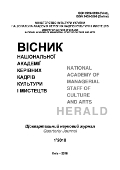MATHEMATICAL MODEL OF THE CURRENCY MARKET, BASED ON FRACTAL ANALYSIS AND ANN CLUSTERING ALGORITHMS
DOI:
https://doi.org/10.32461/2226-3209.1.2018.178195Анотація
Abstract. In the modern economic situation, stock returns and the deviations like market collapses depend on many external factors. When studying financial time series, in order to build a reliable model, it is necessary to use various types of hypotheses regarding the structure of market processes. The main task of a financial investor is to search for information able to predict the immediate future of the asset being studied. Market behavior is modeled both on the basis of theoretical arguments about the nature of market processes and the experimentally gained market knowledge. Basically, the study of financial time series uses methods of statistical analysis. In this paper, a method for determining trends of a time series of financial indicators based on fractal and cluster analyzes is proposed. This
procedure was considered on the example of the study of time series of quotations of foreign currency exchange rates, in particular, the euro from 2010 to 2017. The authors found monthly fractal dimensions of the studied time series and identified the relationship between trends and fractal dimension. Next, a cluster analysis was conducted on fractal dimensions using algorithms based on the use of artificial neural networks (ANN), on the basis of which the types of trends, such as stability, pre-crisis period and crisis situations were determined. To verify the proposed algorithm for
determining the trend of a time series of financial quotations, the euro rate was considered in the period from January 2018 to August 2018. This technique, proposed by the authors for determining the types of periods of time series of financial assets and considered on the example of the euro exchange rate quotations, is universal and can be applied both for securities and financial indicators of commercial enterprises.
Keywords: fractal analysis, cluster analysis, system stability, crisis situations, artificial neural networks
(ANN).
Посилання
Gregory-Williams J., Williams B. Trading chaos. Increasing profits by technical analysis; Trans. from English - M.:
"Alpina Publishers", 2012. - 310 p.
Mandelbrot B., Hudson R. (Non-)Obedient markets: a fractal revolution in Finance; Trans. from English - M.:
Publishing house "Williams", 2006. - 400 p.
Edgar E. Peters. Fractal Market Analysis: Applying Chaos Theory to Investment and Economics. – John Wiley &
Sons, Inc, 1994 – 315p.
. Peters E. Chaos and order in the capital markets. New analytical view on cycles, prices and market volatility; Trans.
from English - M.: Mir, 2000. - 333 p.
V.K. Balkhanov. Fundamentals of fractal geometry and fractal calculus / Chief. Ed. Iu.B. Bashkuev. - Ulan-Ude:
Publishing House of the Buryat State University, 2013. - 224 p.
Khaikin S. Neural networks: the complete book. Ed. 2.: Trans. from English - M.: Publishing House "Williams",
- 1104 p.
Mandelbrot B.B. The fractal geometry nature. – N.Y.: Freeman,1983. – 480 p.
HP Hu, L. Tang, SH. Zhang, HY. Wang. Predicting the direction of stock markets using optimized neural networks
with Google Trends. – Elsevier science bv, po box 211, 1000 ae Amsterdam, Netherlands, Vol. 285, 2018 – PP. 188-
Stojanovic, S. Computational Financial Mathematics using MATHEMATICA®: Optimal Trading in Stocks and
Options - Birkhäuser, Boston, MA, 2003 – 481 p. DOI: https://doi.org/10.1007/978-1-4612-0043-7
Rose C., Smith M.D. Mathematical Statistics with Mathematica – Springer, 2002 – 481 p.
##submission.downloads##
Номер
Розділ
Ліцензія
Автори, які публікуються у цьому журналі, погоджуються з наступними умовами:
1. Автори залишають за собою право на авторство своєї роботи та передають журналу право першої публікації цієї роботи на умовах ліцензії Creative Commons Attribution License, котра дозволяє іншим особам вільно розповсюджувати опубліковану роботу з обов'язковим посиланням на авторів оригінальної роботи та першу публікацію роботи у цьому журналі.
2. Автори мають право укладати самостійні додаткові угоди щодо неексклюзивного розповсюдження роботи у тому вигляді, в якому вона була опублікована цим журналом (наприклад, розміщувати роботу в електронному сховищі установи або публікувати у складі монографії), за умови збереження посилання на першу публікацію роботи у цьому журналі.
3.Політика журналу дозволяє і заохочує розміщення авторами в мережі Інтернет (наприклад, у сховищах установ або на особистих веб-сайтах) рукопису роботи, як до подання цього рукопису до редакції, так і під час його редакційного опрацювання, оскільки це сприяє виникненню продуктивної наукової дискусії та позитивно позначається на оперативності та динаміці цитування опублікованої роботи.

